
Athletic Performance Enhancement…The IMG Academy Way
Share
by: Scott Gadken, Head of Physical Conditioning - IMG Academy
With an increasing number of athletes specializing in sport at an early age, it’s up to the strength and conditioning coaches to create a program that focuses on long term athletic development. Istvan Balyi defines long term athletic development as “optimal training, competition, and recovery with regard to developmental age, while taking into account early, average, and late maturing athletes.”
At IMG Academy, we’ve established 4 pillars of performance that we use to stay true to our training philosophy. Our multi-joint, multi-muscle, multi-plane movement philosophy has laid the foundation for success from our youngest to our professional athletes. Our programming has to be age and ability appropriate with two key goals in mind; to prevent injuries and to create the best athlete possible.
Pillar 1: Movement Based Program
Our first priority to increasing athleticism and preventing injuries is to improve the way athletes move. Many injuries are caused by compensation for a body part that’s not moving or firing correctly. Having the proper ankle, knee, and hip flexibility, glute activation and scapular retraction will help prevent injuries. All movement days are metabolic in nature. We do a prescribed number of drills that elevate the heart rate, and then incorporate “active rest” drills such as walking hamstring, glute, or quad stretching exercises, like a walking straight leg march or a walking leg cradle. All days include various lunge and squat patterns and hip mobility drills performed in a quadruped, supine, or prone position on the turf.
Our movement program is broken down into lateral and linear days. Lateral days include a variety of shuffles, carioca, slides, and lateral jumps. One of the main concepts we teach is the ability to feel the edges and to jump and cut off of both feet; so getting the ankles stronger and more mobile is imperative. Two pieces of equipment you’ll see during all of our lateral sessions are the Spri Speed Ladder and Spri Mini Hurdles. We use both for foot quickness and agility and to improve jumping and landing mechanics.
Linear days are divided up between acceleration and max velocity work. Speed drills include linear build-ups, skipping, and linear jumps. We will do contrast sprints with our athletes using the Spri Weighted Vest and Compact Performance Sled. We’ll do 3 reps resisted, then 3 reps without weight for 3 rounds. The contrast method helps develop power during the acceleration phase of the sprint.
Pillar 2: Corrective Work
Similar to the movement sessions, we also prescribe corrective exercises into our weight room programs. At IMG Academy, we are fortunate to have an outstanding athletic training and physical therapy department, and many other resources like the world-renowned Hospital for Special Surgery on campus. Those resources allow us to see how athletes move, what limitations they have, and previous injury history to build a program that addresses individual areas for improvement. Common deficiencies we see are rounding of the shoulders, poor ankle, knee, hip flexibility, inability to fire the glutes, poor scapular retraction, and poor squatting patterns. We only have 45-60 minutes with each group so we build in corrective work directly into the program. For example, during the back squat, we may superset a Y-T-W-L pattern with the Spri 2 lb vinyl dumbbells, or do our Band Pull-apart Series with the orange Spri Superband, which involves 10 reps each of a straight arm pullapart in front of the chest, diagonal pulls each direction, bent over pulls, and “w” pulls with the hands in a supinated position. While we’re resting the lower body we’ll address corrective exercises for the upper body. Likewise, while performing an upper body exercise like pullups, we may superset a lying clamshell with the Spri Xering bands around the knees to help strengthen weak glutes. We also have corrective programs prepared that athletes can do either before workouts or during their off time that are specifically tailored to the athlete’s weakness. Our goal is to set athletes up for success by fixing them before they’re ever broken so we can build on the progress gained from one training cycle to the next.
SPRI Y-T-W-L
|
The "Y":
|
The "T":
|
The "W":
|
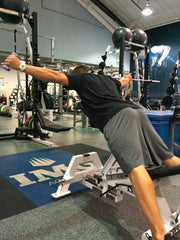 |
 |
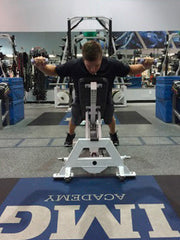 |
| The "L": | The "L": |
|
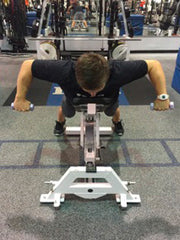 |
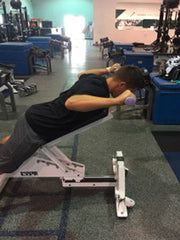 |
Band Pull-Apart Series
| Pull-Apart: | Pull-Apart: |
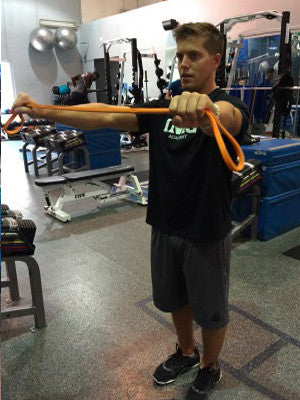 |
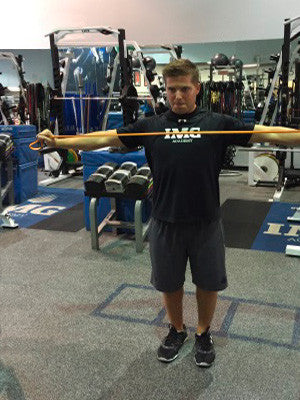 |
| Diagonal (Left Over): | Diagonal (Left Over): |
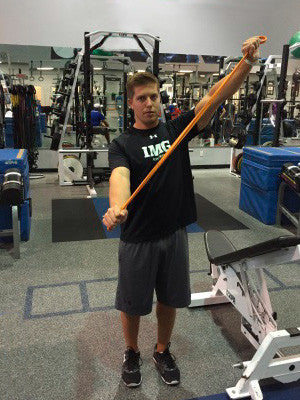 |
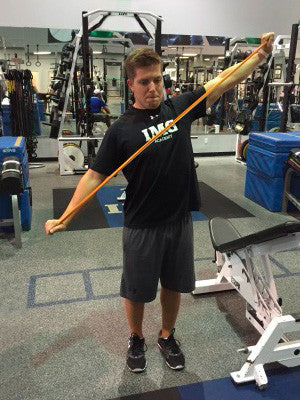 |
| Diagonal (Right Over): | Diagonal (Right Over): |
 |
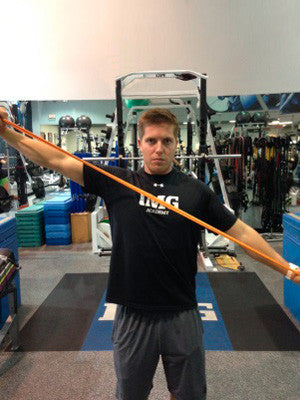 |
| Bent Pull-Apart: | Bent Pull-Apart: |
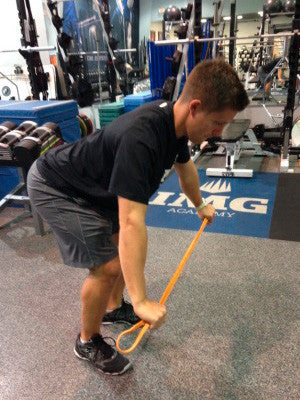 |
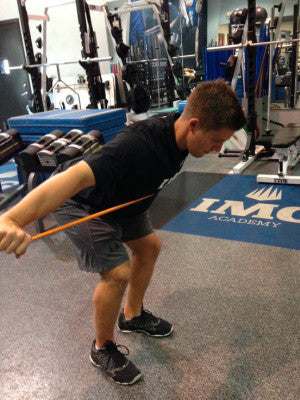 |
| Supinated "W": | Supinated "W" : |
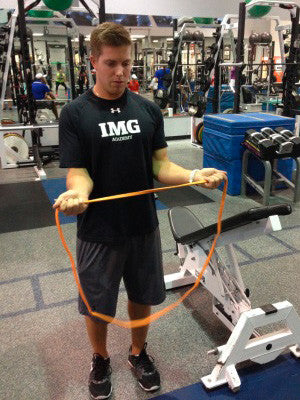 |
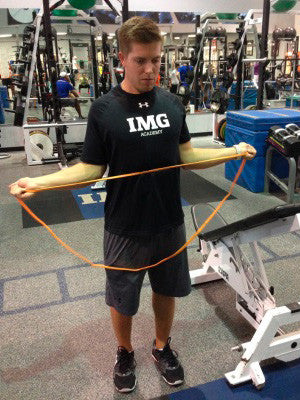 |
Pillar 3: How Fast & How Well, Not How Much
The strength work done in the weight room is determined by technique and bar speed. We focus on lighter weight with excellent technique and bar speed, rather than weights too heavy and moved slowly with poor technique. The goal is to lay a solid training foundation so we can build on our successes. Athletes are not allowed to move up in weight, or move to more advanced programming, until they demonstrate proficiency at their current level. In an IMG Academy weight room session, you would see a great deal of time being spent on proper squatting technique, and a 2:1 ratio of posterior chain to anterior chain work. Some of our athletes use the Olympic lifts, but they have to earn the right to do them by being excellent technicians with the pressing, pulling, and squatting movements leading up Olympic lifting.
Two pieces of equipment used by all our athletes are the Spri Dead Weight Slam Ball and the XTS Training System. We use the ball for metabolic slams and throws with our older athletes, while our younger athletes use it for a number of different exercises, such as a goblet squat, lunges, squat to press, RDL’s, and various core exercises. It’s a great teaching tool and a way for us to lay the foundation before we start incorporate dumbbell and barbell exercises into their programs. The XTS Training System is a tremendous bodyweight training tool. A simple adjustment of the feet and you change the bodyweight resistance. It’s a safe and reliable way for us to introduce pressing and pulling into our programs.
Pillar 4: Rest & Recovery
This is arguably the most important and most overlooked aspect of training. IMG Academy student-athletes spend anywhere from 2-4 hours per day training or practicing, but it’s the other 20 to 22 hours of the day that will dictate their performance. How much sleep did they get last night, how was the quality of sleep, are they hydrated, what does their diet look like, did they eat breakfast? These are questions we ask on a daily basis. We can have the best training program in the world, and the athletes could follow it religiously, but if their sleep, nutrition, and recovery techniques are poor they won’t reap all the benefits of their hard work. One thing we need to be aware of for long term athletic development is overall training load. IMG Academy student-athletes spend a great deal of time training, practicing and competing, so it’s the strength coach’s responsibility to monitor fatigue and trainability. We often schedule “regen” days that include a light movement session with vibration platform, flexibility, pool, and soft tissue manipulation to help accelerate recovery and to help reduce the risk of overtraining.
The 4 Pillars of Performance is how we evaluate, train and test our athletes at IMG Academy. Everything counts, and we use this mindset when we program for the long term athletic development of all our athletes.
To learn more about IMG Academy and our physical conditioning program, visit www.IMGAcademy.com.
